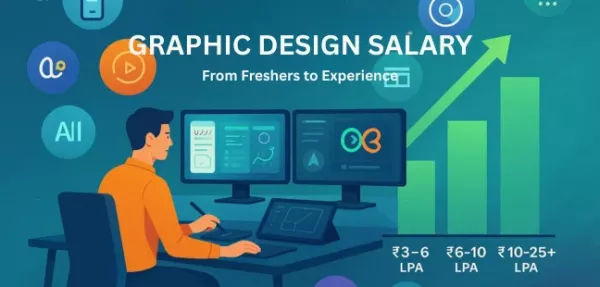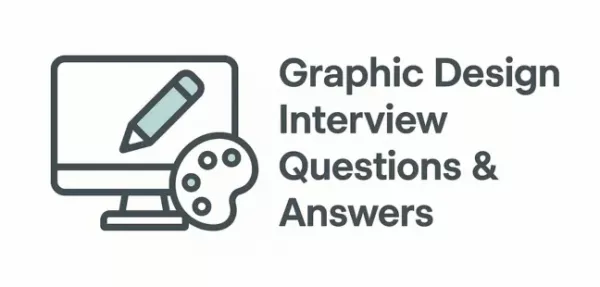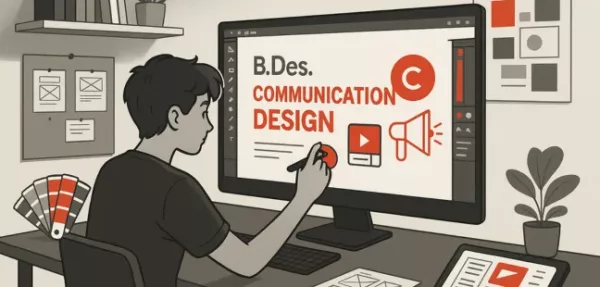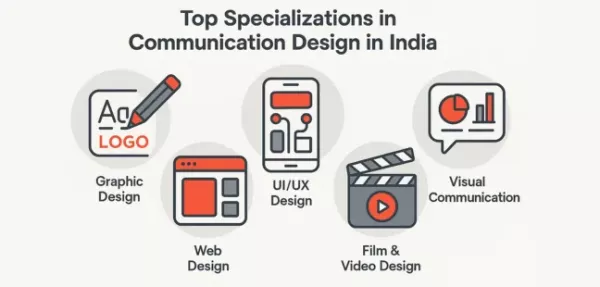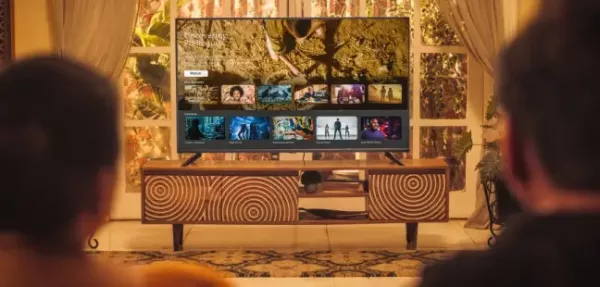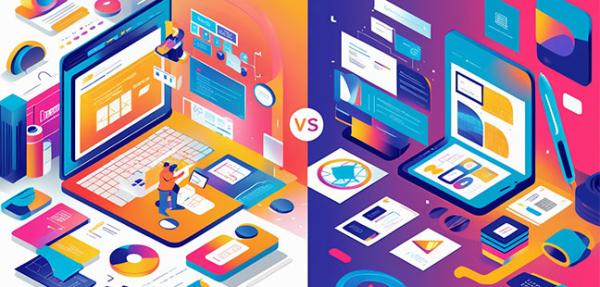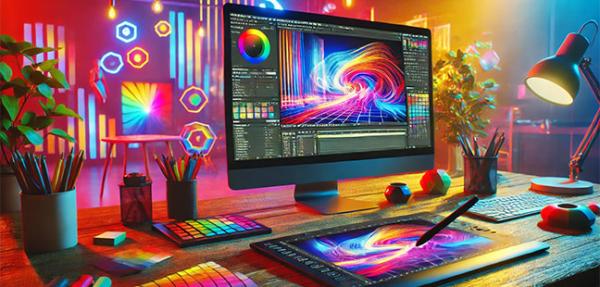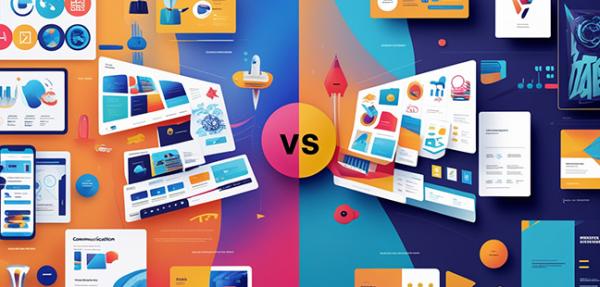Graphic Design Courses After 12th: Top Guide for 2025
- Editorial Team
- Published 10-Jun-2025
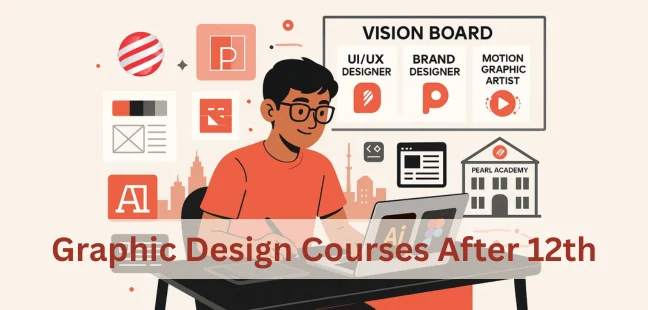
- Why Choose Graphic Design After 12th?
- Who Can Pursue Graphic Design Courses After 12th?
- Top Graphic Design Courses After 12th
- Duration and Curriculum of Graphic Design Courses
- Common Subjects Taught in Graphic Design
- Top Colleges and Institutes Offering Graphic Design Courses in India
- Admission Process for Graphic Design Courses
- Course Fees, Scholarships, and Financial Aid
- Career Options After Graphic Design Courses
- Tools and Software You Will Learn
- Tips to Choose the Right Graphic Design Course After 12th
- Final Thoughts: Start Your Design Journey Today
- FAQs: Students Also Ask
If you wish to harness the creative powers of visual communication through digital art, motion graphics, and typography, pursuing graphic design courses can be your way to unlock your destiny. The sooner you begin the better! The competition is fierce and going straight at your goal with no delays is always the best way to climb the success ladder faster.
We bring to you a blog that helps you discover Graphic design courses after 12th, and act as a complete guide to all your queries. Read on to know more.
Become future-ready with our Communication Design Programs
Know MoreWhy Choose Graphic Design After 12th?
If you have a flair for creativity, an eye for visuals, and a passion for storytelling through design, graphic design could be the perfect career path after 12th. Today, graphic design is not just about making things look good — it plays a crucial role in branding, communication, marketing, and user experience across industries.
With businesses, media, startups, and even educational platforms heavily investing in digital presence, the demand for skilled graphic designers has skyrocketed. A career in graphic design offers an exciting blend of creativity, technology, and practical problem-solving, making it both rewarding and future-proof.
Growing Scope of Graphic Design in India and Abroad
The graphic design industry has expanded rapidly, both in India and internationally. In India alone, the digital economy boom, rise of social media marketing, e-commerce growth, and startup culture have led to an unprecedented demand for graphic designers.
Globally, countries like the USA, Canada, Australia, the UK, and Germany continue to offer excellent opportunities with high salaries and a creative work culture.
From web and app design to branding and advertising, graphic designers are needed everywhere, making it a truly global career with opportunities to freelance, work remotely, or join top companies.
Creative Freedom and Career Opportunities
One of the biggest perks of a career in graphic design is the creative freedom it offers. Graphic designers get to express ideas visually, experiment with colors, typography, layouts, and storytelling formats.
Moreover, the career paths are diverse — you can become a brand designer, UI/UX designer, motion graphics artist, visual content creator, or even an art director with experience.
Whether you choose to work with design agencies, multinational companies, media houses, fashion brands, or tech startups, graphic design offers flexibility, variety, and scope for artistic growth like few other careers.
Industries Hiring Graphic Designers
Graphic designers are in demand across a wide range of industries, including:
- Advertising and Marketing Agencies
- Media and Publishing Houses
- Fashion and Retail Brands
- Tech Companies and Startups
- Entertainment Industry (Film, TV, OTT Platforms)
- Education and E-learning Platforms
- Healthcare and Wellness Brands
- Government and Non-Profit Organizations
Essentially, wherever there’s a need to communicate visually and connect with an audience, graphic designers play a critical role.
Who Can Pursue Graphic Design Courses After 12th?
Graphic design is a career path open to anyone who has a passion for creativity, visual storytelling, and design thinking. Whether you come from an arts, commerce, or science background, if you have an eye for aesthetics and a drive to express ideas visually, you can pursue graphic design after 12th. The field welcomes students from all academic streams who are willing to develop their technical skills and creative mindset.
Eligibility Criteria for Graphic Design Courses
Most undergraduate graphic design programs require you to have completed your 10+2 education from a recognized board (CBSE, ICSE, State Boards, or equivalent).
Some colleges and universities may have additional entrance tests to assess your creativity, design aptitude, and basic drawing skills. Others might conduct interviews or portfolio reviews.
In general, the eligibility is simple:
- Completion of 12th grade (any stream)
- Meeting minimum percentage criteria (varies by institution, usually 45–60%)
- Clearing entrance exams like NID, NIFT, UCEED, or institute-specific design aptitude tests (if applicable)
Skills Needed to Excel in Graphic Design
While eligibility gets you into a course, excelling in graphic design requires a mix of hard and soft skills:
- Creativity and Imagination: Thinking outside the box to create compelling designs.
- Attention to Detail: Precision in layouts, colors, fonts, and branding.
- Knowledge of Design Software: Familiarity with tools like Adobe Photoshop, Illustrator, InDesign, Canva, Figma, and more.
- Visual Communication Skills: Ability to convey messages effectively through design.
- Adaptability: Keeping up with changing design trends and client needs.
- Time Management: Handling multiple projects and deadlines efficiently.
- Problem-Solving: Designing solutions that are both aesthetic and functional.
- Teamwork and Communication: Collaborating with clients, marketers, and developers.
These skills can be developed and honed during your course and through continuous practice.
Streams Allowed (Arts, Commerce, Science)
Good news — students from all streams (Arts, Commerce, Science) can pursue graphic design after 12th!
- Arts Students: Often have an advantage due to early exposure to creative subjects, visual arts, and humanities thinking.
- Commerce Students: Bring strong skills in marketing, business sense, and project management, which are valuable in branding and corporate design.
- Science Students: Have an analytical mindset and tech orientation, which is especially useful for digital design, UI/UX, and interactive media design.
No matter what stream you belong to, your interest, creativity, and willingness to learn are what truly matter in succeeding as a graphic designer.
Top Graphic Design Courses After 12th
After completing your 12th grade, there are several graphic design courses you can pursue depending on your interest, career goals, and the time you wish to invest. From full-fledged degree programs to short-term certifications, the options are diverse and flexible, allowing you to build a strong foundation in design principles, tools, and industry practices.
Course Name | Duration | Focus Areas | Best For | Institutes/Platforms |
| B.Des in Graphic Design | 4 Years | Design thinking, visual communication, branding, typography, digital media, UX design | Students seeking structured, in-depth design education | NID, Pearl Academy, UID, MIT Institute of Design |
| BFA in Graphic Design | 4 Years | Fine arts, creativity, drawing, aesthetics, digital design, visual storytelling | Students interested in blending art with commercial design | Government and private fine arts colleges |
| Diploma in Graphic Design | 1–2 Years | Adobe tools, branding, web design, UI/UX fundamentals | Quick, hands-on, job-ready skills without full degree | Private design institutes, universities |
| Certificate Courses in Graphic Design | 6 Months – 1 Year | Logo/poster/web design, digital marketing creatives, UI/UX basics | Beginners, freelancers, or career switchers | Pearl Academy (Graphics & Motion Design), other private institutes |
| Online Graphic Design Courses | Varies (Self-paced) | Software skills, design theory, branding, portfolio building | Flexible, affordable learning for beginners | Coursera, Udemy, Skillshare, LinkedIn Learning, edX |
Not sure which certification course to choose? Here’s a detailed guide to help you pick the right graphic design certification based on your goals and experience level.
Duration and Curriculum of Graphic Design Courses
Graphic design courses vary widely in their duration and depth, depending on the level of study you choose — from full-time undergraduate degrees to shorter diploma and certificate programs. However, all courses share a common goal: to build your ability to communicate ideas visually with creativity, technology, and purpose.
Course Duration: UG vs Diploma vs Certificate
For the sake of clarity, let us see the differences between the three types of degrees:
Course Type | Duration | Focus | Best For |
| Undergraduate Degree (B.Des / BFA) | 4 Years (8 Semesters) | Comprehensive design theory, practical projects, internships, specializations | Students aiming for strong foundations, global jobs, leadership roles |
| Diploma in Graphic Design | 1 – 2 Years | Skill-based learning, software tools, portfolio building | Students seeking faster job entry or upskilling |
| Certificate Courses | 3 Months – 1 Year | Specific tools (Photoshop, Illustrator), branding, web design | Beginners, freelancers, professionals adding new skills |
Common Subjects Taught in Graphic Design
Across all types of graphic design courses, some core subjects commonly form the curriculum backbone. These include:
Category | Topics Covered |
| Design Fundamentals | Color theory, typography, layout principles |
| Illustration & Drawing | Hand sketching, conceptual illustration |
| Software Training | Photoshop, Illustrator, Lightroom, CorelDraw |
| Digital & UI Tools | Figma, Adobe XD, web & app interface design |
| Creative Applications | Advertising, packaging design, branding |
| Art History & Context | History of art and design |
| Animation & Motion | Motion graphics basics, explainer video design |
| Professional Skills | Portfolio development, presentation skills |
These subjects ensure you have both technical expertise and strong creative thinking abilities to solve real-world design problems.
Specializations Available (UI/UX, Visual Communication, etc.)
Many graphic design courses offer students a chance to specialize in a particular field after completing core modules. Popular specializations include:
Specialization | Focus Area | Ideal For |
| UI/UX Design | User-centric digital interfaces (apps, websites) | Students interested in usability and tech-driven design |
| Visual Communication | Branding, marketing visuals, digital storytelling | Creative visual thinkers |
| Motion Graphics & Animation | Animated videos, title sequences, interactive visuals | Multimedia or video design aspirants |
| Advertising & Branding Design | Campaigns, logos, brand identity | Strategic and marketing-minded creatives |
| Web & App Design | Functional web and mobile UI design | Digital product designers |
| Illustration & Concept Art | Drawing, storytelling visuals for media, publishing | Students passionate about sketching and art-based careers |
Choosing a specialization allows you to tailor your education according to your career aspirations and areas of creative interest.
Top Colleges and Institutes Offering Graphic Design Courses in India
Choosing the right institute plays a crucial role in shaping your graphic design career. India is home to several prestigious design colleges that offer cutting-edge curriculum, strong industry connections, excellent placement support, and a nurturing environment for creative growth. Here are some of the top institutes you should consider:
Institute | Location(s) | Key Highlights | Program Strengths |
| Pearl Academy | Delhi NCR (West & South), Mumbai, Jaipur, Bangalore |
|
|
| NID (National Institute of Design) | Ahmedabad, Gandhinagar, Bengaluru, others |
|
|
| UID (Unitedworld Institute of Design) | Ahmedabad |
|
|
| Srishti Manipal Institute | Bangalore |
|
|
| MIT Institute of Design (MIT-ID) | Pune |
|
|
Admission Process for Graphic Design Courses
Admission into top graphic design programs typically involves a mix of entrance tests, portfolio submissions, and personal interviews. Each institute may have its own criteria, but overall, the process is designed to evaluate your creativity, technical skills, and passion for design.
Entrance Exams (NID DAT, UCEED, Pearl Entrance, etc.)
Many reputed design institutes conduct entrance exams to select eligible candidates for their undergraduate graphic design courses. Some of the major exams include:
Exam Name | Conducted By | Purpose | Focus Areas |
| NID DAT | National Institute of Design | Admission to B.Des & M.Des at NID campuses | Creativity, drawing, observation, visualization |
| UCEED | IIT Bombay | Admission to B.Des at IITs & partner institutes | Design thinking, analytical skills, visual perception |
| Pearl Academy Entrance Exam | Pearl Academy | Admission to UG & PG design programs | Design aptitude, personal interview, portfolio |
| Other Institute-Specific Tests | MIT-ID, UID, Srishti Manipal | Admission to institute-specific programs | Creativity, logical reasoning, GK, design aptitude |
Preparing for these exams requires consistent practice in sketching, visualization, observation, and basic design theory.
Graphic Design Portfolio Guidelines
A portfolio is a crucial part of the admission process, especially for private institutes and international applications. Your portfolio showcases your creativity, originality, technical skills, and passion for design.
Portfolio Requirements | Portfolio Tips |
|
|
Important Dates and Application Process
Each institute releases its application dates and exam schedules separately, usually between October to March for the next academic session starting in July–August.
Stage | Timeline |
| Application Opens | October – January |
| Entrance Exams | January – April |
| Portfolio Review & Interviews | February – May |
| Admission Offers | May – July |
It’s crucial to regularly check the official websites of the institutes you’re applying to and register early to avoid the last-minute rush.
Course Fees, Scholarships, and Financial Aid
Graphic design education can vary in cost depending on the type of course and the institution's reputation. However, many scholarships and financial aid options are available to ease the financial burden for deserving students.
Average Fees for Graphic Design Courses in India
The average course fees for graphic design programs are:
Course Type | Average Fee Range | Notes |
| B.Des / BFA Programs | ₹2,00,000 – ₹6,00,000 per year | Higher at private institutes like Pearl Academy, UID, MIT-ID |
| Diploma Courses | ₹50,000 – ₹2,00,000 (total) | Affordable, job-oriented option |
| Certificate Courses | ₹20,000 – ₹1,00,000 (total) | Short-term skill-building programs |
Top private institutes like Pearl Academy, UID, and MIT-ID tend to have higher tuition fees compared to government institutions like NID.
Scholarships for Design Students
Several institutes and external organizations offer scholarships based on merit, need, and talent:
Scholarship Name | Offered By | Eligibility / Type |
| Pearl Academy Scholarships | Pearl Academy | Based on merit and entrance exam scores |
| NID Scholarships | National Institute of Design + external funders | Based on financial need and academic merit |
| Inlaks Scholarships | Inlaks Shivdasani Foundation | For higher studies abroad in design/art |
| UGC & State Scholarships | Government of India / State govts | For EWS, minority, and differently-abled students |
Students are advised to apply early for scholarships and carefully read eligibility criteria.
Education Loans for Design Aspirants
Many public and private banks in India offer education loans covering tuition fees, hostel expenses, and even equipment like laptops and software needed for design courses.
Some popular options include:
- SBI Education Loan
- HDFC Credila
- Axis Bank Education Loan
- Avanse Financial Services
Generally, collateral-free loans are available for amounts up to ₹7.5 lakhs. Students should compare interest rates, moratorium periods, and repayment options before choosing a loan provider.
Career Options After Graphic Design Courses
Completing a graphic design course opens up a world of creative career opportunities. With digital media, branding, and online content booming, graphic designers are essential across industries — from startups to multinational corporations, from fashion houses to tech giants. Whether you prefer working for a company or freelancing independently, the possibilities are diverse and exciting.
Explore 5 practical tips for landing your first job as a graphic designer to kickstart your career with confidence. Before you walk into your first interview, make sure you’re well-prepared—check out our detailed Graphic Design Interview Questions and Answers guide that covers what recruiters actually ask and how to answer with confidence.
Job Roles (Graphic Designer, Art Director, Visual Designer, etc.)
Here are some of the top career roles you can explore after a graphic design course:
Job Role | Description |
| Graphic Designer | Creates visual content for websites, brands, ads, and social media |
| Visual Designer | Designs multimedia visuals and digital interfaces blending aesthetics and functionality |
| Art Director | Leads design teams and manages overall creative direction for campaigns and media |
| UI/UX Designer | Specializes in user-centric interface and experience design for apps and websites |
| Brand Identity Designer | Develops logos, brand systems, and cohesive visual identities |
| Motion Graphics Designer | Creates animated visuals for digital platforms, videos, and advertising |
| Illustrator / Concept Artist | Produces original artwork for publishing, games, films, and digital media |
| Web & App Designer | Designs UI layouts, web flows, and mobile user journeys |
| Packaging Designer | Creates product packaging like boxes, bottles, and containers with visual appeal |
Each of these roles offers different avenues to specialize further, depending on your interests and skill development.
Freelancing and Remote Work Opportunities
Graphic design is one of the best fields for freelancing and remote work.
Freelancing Platforms | Benefits of Freelancing |
| Upwork, Fiverr, Freelancer, Behance |
|
Additionally, many companies now offer remote full-time roles for graphic designers, especially startups, tech firms, and digital agencies.
Salary Expectations for Freshers and Experienced Professionals
Starting salaries vary based on the city, company size, your skill set, and portfolio quality.
Experience Level | Salary (India) | Salary (Abroad) |
| Freshers (0–2 yrs) | ₹2.5 – ₹5 LPA ₹6–8 LPA for UI/UX | $50,000–$80,000 (Graphic Design) $90,000+ (UI/UX) |
| Experienced (3–7 yrs) | ₹6 – ₹15 LPA or more based on role & company | Higher salaries depending on country and portfolio strength |
| Freelancers | Highly variable: ₹30,000–₹2 Lakhs+ per project | Can scale higher based on client base and specialization |
Freelancers with strong client bases can often earn even more based on projects delivered.
Tools and Software You Will Learn
Mastering industry-standard tools is essential to succeed as a graphic designer. Most courses will train you in professional design software and teach you best practices for visual storytelling, branding, and digital communication.
Adobe Creative Suite (Photoshop, Illustrator, InDesign)
The Adobe Creative Suite is the backbone of the graphic design industry:
Software | Primary Use | Ideal For |
| Adobe Photoshop | Photo editing, digital painting, compositing | Web graphics, social media visuals, image retouching |
| Adobe Illustrator | Vector illustration, logo design, typography | Branding, infographics, scalable artwork |
| Adobe InDesign | Layout design for print and digital publications | Magazines, brochures, books, editorial work |
Learning these tools gives you versatility across print, web, and digital projects.
Figma, Sketch, CorelDraw
Besides Adobe, you’ll also learn other modern tools depending on your specialization:
Tool | Use Case | Best Suited For |
| Figma | Collaborative UI/UX and web design | Interface design, wireframes, prototypes |
| Sketch | Vector-based interface design | Mobile & web UI/UX (Mac-only) |
| CorelDraw | Vector illustration & print design | Print media, signage, advertising layouts |
Knowledge of multiple tools gives you flexibility and a competitive edge in the market.
Typography, Branding & Layout Techniques
Beyond software, top courses will teach essential design principles and techniques, including:
| Design Area | Key Concepts Taught |
| Typography | Font selection, hierarchy, readability, pairing |
| Branding | Logo creation, visual identity, brand colors, consistency |
| Layout Techniques | Page structure, balance, white space, alignment, grids |
Strong command over these foundational techniques is what separates an average designer from an exceptional one.
Tips to Choose the Right Graphic Design Course After 12th
Choosing the right graphic design course after 12th is a crucial decision that can shape your future career. Here’s a guide on what to consider when choosing the best graphic design course to help you evaluate your options with clarity.
With so many options available, it’s important to select a program that aligns with your passion, goals, and growth potential. Here’s how you can make the right choice:
Evaluate Your Interests and Career Goals
Before selecting a course, ask yourself:
- Do you enjoy branding, illustration, UI/UX design, animation, or advertising?
- Are you aiming for a full-time creative career or freelancing flexibility?
- Are you more inclined towards digital media or traditional print design?
Choosing a course that matches your personal interests and long-term career aspirations ensures that you stay motivated and excel in your studies and professional life.
Compare Course Curriculum and Faculty
Not all graphic design courses are created equal. Look closely at:
- Course Curriculum: Does it cover the latest tools (like Figma, Adobe XD), emerging fields (UI/UX, motion graphics), and strong portfolio-building projects?
- Faculty Expertise: Are the professors industry practitioners, experienced designers, or researchers?
- Hands-on Learning: Does the program offer workshops, internships, industry projects, and portfolio showcases?
A strong curriculum combined with experienced mentorship can make a significant difference in your learning journey.
Look at Placement Records and Alumni Success
Placement support and alumni networks matter greatly.
- Placement Rates: What percentage of students get placed after graduation?
- Recruiter List: Are reputed companies and design studios recruiting from the institute?
- Alumni Success Stories: Where are the alumni working today? Are they in creative leadership roles, top brands, or running successful design businesses?
An institute with strong industry connections and proven alumni success gives you better professional visibility and opportunities after graduation.
Final Thoughts: Start Your Design Journey Today
Graphic design is among the most dynamic and future-ready careers today. It merges creativity with technology and opens countless avenues for self-expression, innovation, and global impact. If you have a passion for visual storytelling, problem-solving, and creative thinking, there’s no better time to step into the design world.
Why Now is the Best Time to Begin Your Graphic Design Career
Enrolling in a field currently experiencing rapid growth is a smart career move. Here’s why now is the ideal time to pursue a graphic design degree:
- Booming Digital Economy: With startups, e-commerce, social media, and digital marketing expanding, the demand for graphic designers is at an all-time high.
- Global Opportunities: Remote work has made it possible to collaborate with international brands and agencies from anywhere.
- Creative Satisfaction: Graphic design offers the rare joy of seeing your ideas come to life and making a visible impact on brands and communities.
- High Growth Potential: Skilled designers can quickly rise to senior roles like Creative Director, UX Lead, or start their own design agencies.
Starting now gives you the advantage of building a strong foundation early and riding the wave of opportunities.
How to Apply Online and Get Started
Applying for graphic design courses is easier than ever with online application systems:
- Research Institutes: Make a shortlist of colleges and courses that align with your goals.
- Check Eligibility and Entrance Dates: Visit official websites for entrance exam details (like NID DAT, UCEED, Pearl Academy Entrance).
- Prepare a Portfolio: If needed, start working on your portfolio showcasing your creativity and design thinking.
- Fill Application Forms: Complete online forms carefully, upload required documents, and pay the application fee.
- Prepare for Entrance Exams: Practice aptitude tests, design problem-solving, and brush up on basic drawing skills.
- Attend Interviews/Portfolio Reviews: Some colleges require a personal interview or portfolio review after the written test.
- Confirm Admission: Once selected, pay the admission fee and complete enrolment formalities to begin your exciting journey!
Stay updated with important dates, entrance procedures, and portfolio deadlines. Admissions often open quickly—so don’t miss your chance to apply.
Get ready to enrol in Pearl Academy’s Graphics and Motion Design short-term Certificate course. Apply Now!
FAQs: Students Also Ask
Q.1- Is graphic design a good career after 12th?
A. Yes, graphic design is a great career option after 12th for creative students interested in visual storytelling and digital design. With rising demand across industries, graphic designers can work in branding, advertising, media, tech, and freelance sectors.
Q.2- Can I pursue graphic design without maths?
A. Yes, you can pursue graphic design without maths. Most graphic design courses after 12th don’t require advanced math knowledge. Creative thinking, software skills, and visual communication are more important than mathematical ability.
Q.3- Which stream is best for graphic design?
A. Students from any stream — Arts, Commerce, or Science — can pursue graphic design after 12th. Arts students often have a head start in creativity, but passion and skills matter more than your academic background.
Q.4- What is the salary of a graphic designer after completing a degree?
A. Entry-level graphic designers in India earn ₹2.5–₹5 LPA. Specialized roles like UI/UX design may offer ₹6–8 LPA. With experience, salaries can grow to ₹8–15 LPA or more.
Q.5- Is graphic design easy to learn after 12th?
A. Yes, graphic design is easy to start learning after 12th with interest and dedication. With practice and training in tools like Photoshop, Illustrator, and Figma, students can build strong portfolios.
Q.6- Which entrance exam is required for graphic design?
A. Common graphic design entrance exams include NID DAT, UCEED, Pearl Academy Entrance Test, and institute-specific tests like MITID DAT and UID DAT. Some colleges also offer direct admission based on portfolio and interview.
Q.7- Can I do graphic design online after 12th?
A. Yes, many platforms offer online graphic design courses for beginners after 12th. You can learn on Coursera, Udemy, Skillshare, or Pearl Academy Online and build your design skills and portfolio at your own pace.
Tags
- #Communication Design
Pearl Admission Enquiry
Subscribe to Pearl Blogs
By clicking the "Subscribe" button, I agree and accept the privacy policy of Pearl Academy.














